View in other NatureServe Network Field Guides
NatureServe
Montana
Utah
Wyoming
Idaho
Wisconsin
British Columbia
South Carolina
Yukon
California
New York
Black Gloss Snail - Zonitoides nitidus
Other Names:
Helix nitida, Zonites nitidus, Hyalina hydrophyla
General Description
A small shell, to about 6 mm diameter or more and 3 mm in height, flattened heliciform with weak wrinkle-like axial striae, 4 ½ to 5 whorls, the last not greatly expanded. Shell coloration is somewhat transparent and shiny olive to brown. Aperture is crescent-shaped, wider than high, lacking teeth (denticles), periphery rounded; umbilicus about 1/5 the shell diameter. Animal is dark to blackish, mantle with a dull orange spot visible through the shell behind the aperture (Hendricks 2012, Burke 2013). Internal anatomy is described by Pilsbry (1946).
Diagnostic Characteristics
A combination of small size (to about 6 mm diameter), whorls of much the same size (the last not greatly expanding), brownish color, relatively flat spire, relatively narrow umbilicus 1/4 or less the shell diameter), and shell generally smooth or wrinkled (not with striae or riblets), distinguishes Zonitoides from other shells. Z. nitidus differs from Z. arboreus by being larger (to 6.0 mm diameter or more), having a slightly elevated spire, the shell transparent olive to brown, and the mantle of the live animal with a dull orange spot visible through the shell behind the aperture.
Species Range
Montana Range
Range Descriptions
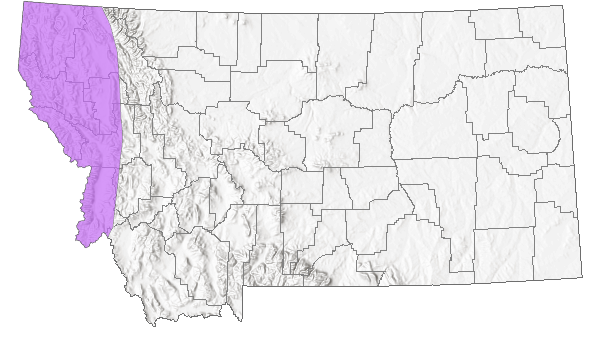
 Native
Native
Range Comments
Across much of the Northern Hemisphere. In Montana, reported west of the Continental Divide from the Bitterroot Valley in Ravalli County, between Stevensville and Darby, and along the Stillwater River in Flathead County. Elevation range is 991 to 1372 m (3250 to 4500 ft). Range in Montana possibly under-represented due to mistaken identification as Zonitoides arboreus, especially dead shells; possibly introduced to the state. Only a few individuals so far have been reported at any site (Hendricks 2012).
Observations in Montana Natural Heritage Program Database
Number of Observations: 3
(Click on the following maps and charts to see full sized version)
Map Help and Descriptions
Relative Density
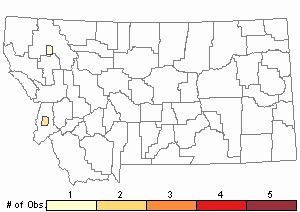
Recency
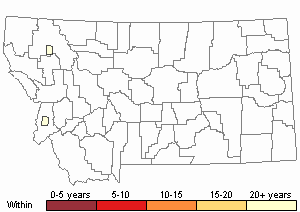
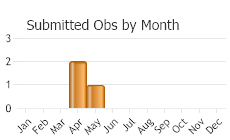
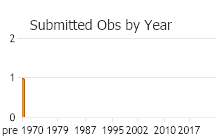
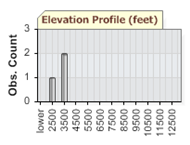 (Observations spanning multiple months or years are excluded from time charts)
(Observations spanning multiple months or years are excluded from time charts)
Habitat
Usually at lower elevations near wetlands and marshy places, never in forested uplands. Found under woody debris and rocks, in leaf litter or duff (Hendricks 2012).
Stewardship Responsibility
References
- Literature Cited AboveLegend:
 View Online Publication
View Online Publication Burke, T. E. 2013. Land snails and slugs of the Pacific Northwest. Corvallis, OR: Oregon State University Press. 344 p.
Burke, T. E. 2013. Land snails and slugs of the Pacific Northwest. Corvallis, OR: Oregon State University Press. 344 p. Hendricks, P. 2012. A Guide to the Land Snails and Slugs of Montana. A report to the U.S. Forest Service - Region 1. Montana Natural Heritage Program, Helena, MT. vii + 187 pp. plus appendices.
Hendricks, P. 2012. A Guide to the Land Snails and Slugs of Montana. A report to the U.S. Forest Service - Region 1. Montana Natural Heritage Program, Helena, MT. vii + 187 pp. plus appendices. Pilsbry, H.A. 1946. Land Mollusca of North America (north of Mexico), Volume II Part 1. Academy of Natural Sciences of Philadelphia Monograph Number 3 (2):1-520.
Pilsbry, H.A. 1946. Land Mollusca of North America (north of Mexico), Volume II Part 1. Academy of Natural Sciences of Philadelphia Monograph Number 3 (2):1-520.
- Additional ReferencesLegend:
 View Online Publication
View Online Publication
Do you know of a citation we're missing? Brunson, R.B., and U. Osher. 1957. Haplotrema from western Montana. Nautilus 70: 121-123.
Brunson, R.B., and U. Osher. 1957. Haplotrema from western Montana. Nautilus 70: 121-123. Forsyth, R.G. 2004. Land snails of British Columbia. Royal British Columbia Museum: Victoria, British Columbia, Canada. 188 pp.
Forsyth, R.G. 2004. Land snails of British Columbia. Royal British Columbia Museum: Victoria, British Columbia, Canada. 188 pp. Frest, T.J. and E.J. Johannes. 2001. An annotated checklist of Idaho land and freshwater mollusks. Journal of the Idaho Academy of Science 36(2):1-51.
Frest, T.J. and E.J. Johannes. 2001. An annotated checklist of Idaho land and freshwater mollusks. Journal of the Idaho Academy of Science 36(2):1-51. Vanatta, E.G. 1914. Montana shells. Proceedings of the Academy of Natural Sciences of Philadelphia 66:367-371.
Vanatta, E.G. 1914. Montana shells. Proceedings of the Academy of Natural Sciences of Philadelphia 66:367-371.
- Web Search Engines for Articles on "Black Gloss Snail"
- Additional Sources of Information Related to "Snails / Slugs"





